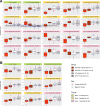This is a preprint.
Rescue of hippocampal synaptic plasticity and memory performance by Fingolimod (FTY720) in APP/PS1 model of Alzheimer's disease is accompanied by correction in metabolism of sphingolipids, polyamines, and phospholipid saturation composition
- PMID: 39868189
- PMCID: PMC11761635
- DOI: 10.1101/2025.01.17.633452
Rescue of hippocampal synaptic plasticity and memory performance by Fingolimod (FTY720) in APP/PS1 model of Alzheimer's disease is accompanied by correction in metabolism of sphingolipids, polyamines, and phospholipid saturation composition
Abstract
Previously, our metabolomic, transcriptomic, and genomic studies characterized the ceramide/sphingomyelin pathway as a therapeutic target in Alzheimer's disease, and we demonstrated that FTY720, a sphingosine-1-phospahate receptor modulator approved for treatment of multiple sclerosis, recovers synaptic plasticity and memory in APP/PS1 mice. To further investigate how FTY720 rescues the pathology, we performed metabolomic analysis in brain, plasma, and liver of trained APP/PS1 and wild-type mice. APP/PS1 mice showed area-specific brain disturbances in polyamines, phospholipids, and sphingolipids. Most changes were completely or partially normalized in FTY720-treated subjects, indicating rebalancing the "sphingolipid rheostat", reactivating phosphatidylethanolamine synthesis via mitochondrial phosphatidylserine decarboxylase pathway, and normalizing polyamine levels that support mitochondrial activity. Synaptic plasticity and memory were rescued, with spermidine synthesis in temporal cortex best corresponding to hippocampal CA3-CA1 plasticity normalization. FTY720 effects, also reflected in other pathways, are consistent with promotion of mitochondrial function, synaptic plasticity, and anti-inflammatory environment, while reducing pro-apoptotic and pro-inflammatory signals.
Conflict of interest statement
Disclosures and competing interests Karel Kalecký and Teodoro Bottiglieri are authors of the Integrator software, which was used for quantification of chromatographic signal, and which implements an approach described in a patent application (Application # PCT/US24/51426, filed on October 15, 2024) that is currently pending. Dr. Kaddurah-Daouk is an inventor on a series of patents on use of metabolomics for the diagnosis and treatment of CNS diseases and holds equity in Metabolon Inc., Chymia LLC and PsyProtix.
Figures







Similar articles
-
Anti-Inflammatory Treatment with FTY720 Starting after Onset of Symptoms Reverses Synaptic Deficits in an AD Mouse Model.Int J Mol Sci. 2020 Nov 25;21(23):8957. doi: 10.3390/ijms21238957. Int J Mol Sci. 2020. PMID: 33255764 Free PMC article.
-
Modulatory Effects of Fingolimod (FTY720) on the Expression of Sphingolipid Metabolism-Related Genes in an Animal Model of Alzheimer's Disease.Mol Neurobiol. 2019 Jan;56(1):174-185. doi: 10.1007/s12035-018-1040-x. Epub 2018 Apr 23. Mol Neurobiol. 2019. PMID: 29687345 Free PMC article.
-
Impairment of Spike-Timing-Dependent Plasticity at Schaffer Collateral-CA1 Synapses in Adult APP/PS1 Mice Depends on Proximity of Aβ Plaques.Int J Mol Sci. 2021 Jan 30;22(3):1378. doi: 10.3390/ijms22031378. Int J Mol Sci. 2021. PMID: 33573114 Free PMC article.
-
Repurposing drugs against Alzheimer's disease: can the anti-multiple sclerosis drug fingolimod (FTY720) effectively tackle inflammation processes in AD?J Neural Transm (Vienna). 2023 Aug;130(8):1003-1012. doi: 10.1007/s00702-023-02618-5. Epub 2023 Apr 4. J Neural Transm (Vienna). 2023. PMID: 37014414 Free PMC article. Review.
-
Exploring Sphingolipid Implications in Neurodegeneration.Front Neurol. 2020 May 21;11:437. doi: 10.3389/fneur.2020.00437. eCollection 2020. Front Neurol. 2020. PMID: 32528400 Free PMC article. Review.
References
Publication types
Grants and funding
LinkOut - more resources
Full Text Sources
Miscellaneous
